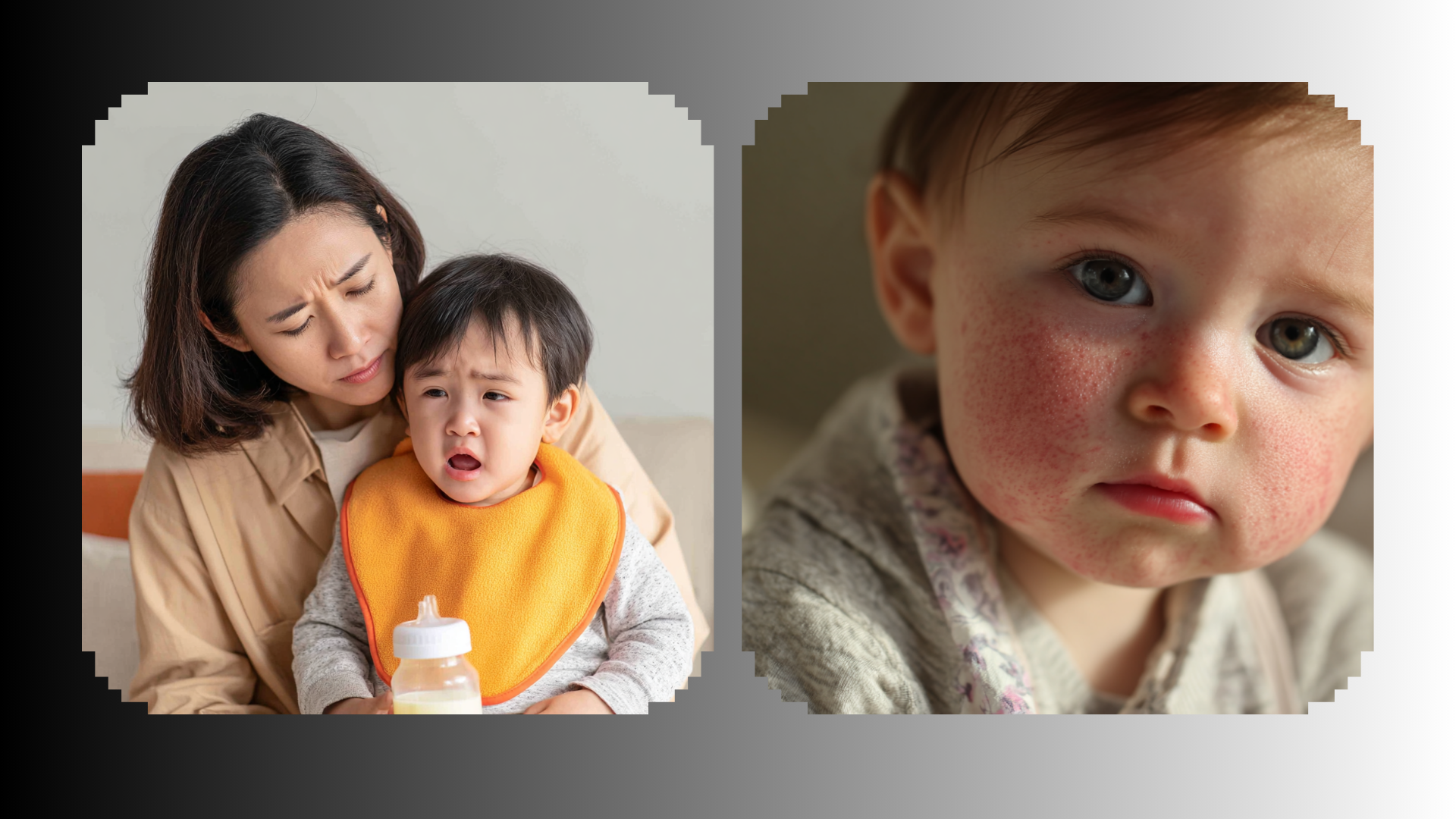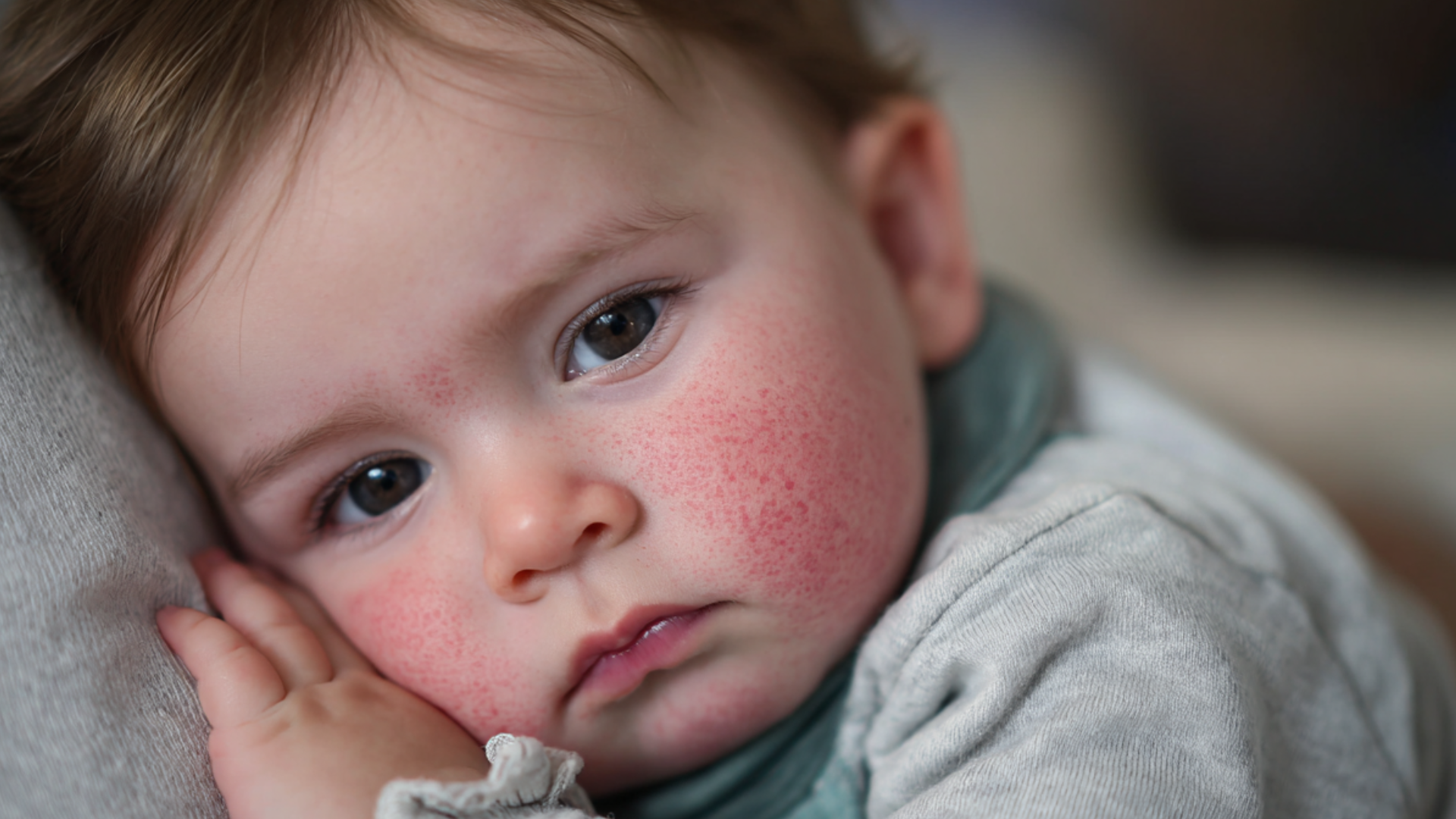Have you ever wondered why some babies get rashes, runny noses, or upset stomachs after eating or being around certain things?
These could be signs of allergies in babies, a common concern many parents face. Allergies happen when the immune system overreacts to something harmless, like food, dust, or pollen.
In this guide, you’ll learn what causes allergies, the common symptoms to look for, and how doctors diagnose and manage them.
What Are Allergies in Babies?
Allergies in babies happen when their immune system reacts to something harmless, like certain foods, dust, or pollen. Instead of ignoring it, their body treats it like a threat.
This reaction can show up in different ways, such as rashes, runny noses, coughing, or tummy troubles. Some babies may only have mild discomfort, while others can have stronger reactions.
Because babies can’t explain how they feel, spotting these signs early is important. Understanding allergies helps you keep your little one safe and comfortable.
Common Causes of Allergies in Babies

Allergies in babies can come from what they eat, what they breathe in, or even family history. Knowing the triggers helps you prevent and manage reactions early.
1. Food Allergens
Certain foods are the most common cause of allergic reactions in babies. Introducing them slowly and watching for symptoms is important.
- Cow’s milk and dairy products: A leading cause of infant allergies, often showing up as skin rashes or digestive problems.
- Eggs: Can trigger hives, stomach upset, or breathing issues in sensitive babies.
- Peanuts and tree nuts: Among the most serious allergens, sometimes leading to strong reactions.
- Soy: Common in formulas and processed foods, may cause diarrhea or fussiness.
- Wheat: Linked to rashes or digestive discomfort when introduced early.
- Fish and shellfish: Strong allergens that often cause reactions even in small amounts.
2. Environmental Triggers
Babies are sensitive to things in their surroundings, from dust to pets. These triggers can cause sneezing, itchy skin, or breathing problems.
- Dust mites: Tiny insects found in bedding and carpets that often cause stuffy noses.
- Pollen from trees and grass: A Seasonal trigger that can lead to runny noses and watery eyes.
- Pet dander: Proteins in skin flakes or fur from cats and dogs may irritate babies.
- Mold spores: Thrive in damp places and can cause coughing or congestion.
- Cigarette smoke or strong odors: Irritate a baby’s airways and worsen allergy symptoms.
3. Genetic Factors
Family history often influences a baby’s risk of developing allergies. If allergies run in the family, your little one may be more likely to show symptoms too.
- Parental allergies: Babies with one or both parents who have allergies face a higher chance of reacting to foods or the environment.
- Asthma in the family: A history of asthma can increase the likelihood of breathing-related allergies.
- Eczema link: Families with eczema often see babies develop similar skin issues tied to allergies.
- Sibling allergies: If an older brother or sister has food or environmental allergies, the younger child may also be at risk.
Signs and Symptoms of Baby Allergies

Allergies can manifest in various ways. Here are some of the main types of symptoms so you can spot them quickly:
1. Skin Symptoms
Rashes, hives, eczema flare-ups, or swelling around the lips or eyes are often the first visible signs of food or environmental allergies. These skin reactions can appear quickly after exposure and are usually your earliest clue that something isn’t right.
2. Respiratory Symptoms
These can also signal allergies. They may look like a common cold, but allergic symptoms often last longer or appear seasonally rather than clearing up in a few days. If symptoms return regularly at the same time each year, it’s likely linked to allergens like pollen or dust.
3. Digestive Symptoms
Vomiting, diarrhea, stomach pain, or excessive gas are common with food allergies, especially from milk, soy, or eggs. These symptoms usually appear soon after feeding or introducing new foods. Keep a food diary to help identify triggers and discuss them with your child’s pediatrician.
4. Severe (Anaphylaxis) Symptoms
Difficulty breathing, swelling of the tongue or throat, or sudden drowsiness are signs of anaphylaxis, a rare but life-threatening reaction. This requires immediate emergency care. Always keep an epinephrine auto-injector (if prescribed) and know when and how to use it in an emergency
How to Tell If It’s an Allergy or Something Else
Sometimes allergy symptoms look like other common baby issues.
| Condition | Common Symptoms | Key Difference from Allergies |
|---|---|---|
| Colds | Runny or stuffy nose, mild cough, low fever | Usually clears in about a week and includes a fever, unlike allergies |
| Food Intolerances | Gas, bloating, diarrhea, and fussiness after certain foods | Doesn’t involve the immune system; no hives, swelling, or breathing trouble |
| Teething | Drooling, chewing on objects, mild fussiness, sore gums | May cause a slight runny nose, but no skin rashes or tummy problems |
| Skin Irritations | Dry skin, heat rash, diaper rash | Localized issue without sneezing, wheezing, or digestive upset |
| Reflux | Frequent spitting up, back arching, irritability after feeds | Doesn’t cause hives, swelling, or breathing issues |
| Colic | Long crying spells, often in the evening |
No rashes, runny noses, or digestive problems like allergies can cause |
How Allergies Are Diagnosed and Managed
Noticing symptoms is only the first step. Parents also want to know what happens at the doctor’s office and how allergies are handled day-to-day.
Diagnosis: How Allergies Are Identified
Doctors use a few common methods to confirm whether your baby has an allergy:
- Skin prick tests: Small drops of allergens are placed on your baby’s skin to check for redness or swelling.
- Blood tests: Measure how the immune system reacts to specific allergens; helpful if skin testing isn’t possible.
- Elimination diets: Certain foods are removed and slowly reintroduced under medical supervision to track reactions.
- Medical history review: The doctor asks about family allergies, feeding habits, and past symptoms to spot patterns.
Management: How Allergies Are Handled
Once allergies are confirmed, the focus shifts to comfort and prevention:
- Avoiding triggers: Read labels carefully, clean often, and adjust routines to reduce exposure.
- Medications: Doctor-approved antihistamines or creams can ease itching, rashes, and swelling.
- Emergency care: Severe allergies may require an epinephrine auto-injector (EpiPen). Parents are trained on how to use it.
- Monitoring growth: Babies with food allergies need regular checkups to ensure healthy nutrition and development.
When to Seek Medical Help
Allergies in babies can vary from mild discomfort to serious reactions. Knowing when to call your doctor and when to seek emergency care helps you respond quickly and safely.
If your baby’s rash spreads quickly, they seem unusually fussy, or digestive issues such as vomiting and diarrhea don’t settle, it’s time to call your doctor.
You should also reach out if symptoms like rashes, runny noses, or stomach problems keep returning.
Keeping a brief record of when these occur can help your doctor identify patterns and triggers.
Get medical advice before reintroducing foods after an allergic reaction, especially strong allergens like peanuts or eggs.
For ongoing concerns that affect sleep, growth, or overall comfort, consulting a specialist can provide long-term support.
Seek emergency care immediately if your baby:
- Has trouble breathing or persistent wheezing
- Develops swelling around the lips, tongue, or face
- Becomes unusually drowsy or unresponsive
Recognizing these signs early and acting fast ensures your baby stays safe and gets the right care when it’s needed most.
Conclusion
Understanding allergies in babies helps you respond calmly and confidently when symptoms appear. Every child is different, so what triggers one baby may not affect another.
Paying attention to small signs and maintaining open communication with your doctor can make a big difference in early management.
With the right awareness and care, most babies grow healthier and more comfortable over time.
If you’re ready to take the next step, start tracking your baby’s symptoms today and talk with your pediatrician about the best plan for managing allergies.










